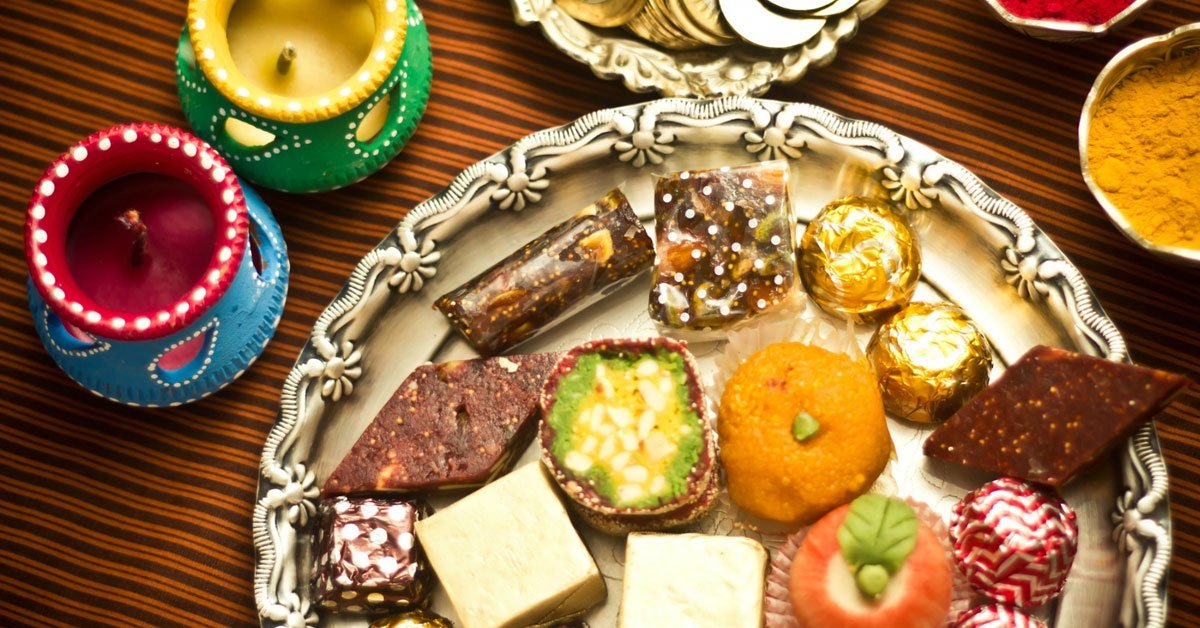Diwali Festival Food – The festival of lights, “Diwali” – celebrated by Hindus, Jains, and Sikhs has become increasingly popular even in countries such as Malaysia, Indonesia, and Singapore where the festive fare reflects local traditions. Though we are residing in the Indian subcontinent most of us are unfamiliar with common Diwali foods. So through this post, we are making you familiar with some of the known and unknown special Diwali Food – What’s Your Diwali festival food.
The immediate answer one gives is sweets – and plenty of them. Indian sweets, known as “mithai” is a combination cross between snack, dessert, and confectionery.
If there’s one thing that captures the Indian culinary psyche, it’s mithai – The staple food for any festival.
One special dish Marshi halwa, where Chickpea flour, rice flour, semolina, various beans, lentils and grains, squashes, carrots, thickened condensed milk, or yogurt are normally used as base ingredients; to which cashew nuts, almonds, pistachios, chirongi nuts or raisins are added. Fragrant with sweet spices like cardamom, cinnamon, cloves, or nutmeg, they’re further blinged up with saffron, rose or kewra (pandan leaf) water, and silver or gold leaf.
While “laddoos”, “barfis” and “halwas” are universally popular, some other items like “mawa kachori”, “motipak” and “Sohan papdi” are more regional specialities requiring elaborate preparation.
It’s customary to exchange extravagantly decorated boxes of mithai, dried fruit, nuts or silver serving dishes with family and friends.
Around a month before the festival starts, women of all generations, get together in each other’s kitchens in turn to make the all-important Diwali snacks. Snack-making is very much a social activity, with older women turning out a dozen or more items and young people keeping the tradition alive by making at least a few.
Diwali snacks, made from chickpeas, rice, lentil and several other varieties of flours, are seasoned with different combinations of spices, sesame seeds, fresh fenugreek leaves or coconut, pummelled into assorted shapes, and usually deep-fried – though nowadays both mithai and snacks are available in low-fat, low-sugar and baked versions. It’s common for family and friends to drop around at each other’s houses with boxes of homemade snacks.
Diwali festival food specialties include Bombay-mix like “chivda”, with countless variations diamond-shaped “shakkarpara”, noodle-like “sev”, sweet, layered deep-fried discs “chirote”, and a range of sweet and savory “puris” from puffed ones that look like UFOs, to ones dented with the back of a thin rolling pin that resembles the surface of the moon.
Different specialty meals are traditionally cooked on different days of the festival, and these vary further depending on the region. Generally speaking puris, traditionally deep-fried in ghee and therefore rich in every sense, replace flatbreads; and are accompanied by a different dal, vegetable curry, fried titbits such as pakoras, collectively known as “namkeen” or “farsan”, and a pudding on each day of the festival. Many, though not all, Indians continue to eat vegetarian at this time of year.
On the first day “Dhanteras”, associated with wealth, large-grain cracked wheat sautéed with ghee and sugar known as “lapse” is very popular, and may be accompanied by a curry of yard-long beans which, due to their length, symbolize longevity.
On the second day “Naraka Chaturdashi”, associated with the elimination of evil spirits, specialties include “anarasa”, a rice-and-jaggery dish that can take up to seven days to prepare. Light, fluffyurad lentil pakoras are eaten alongside the milky rice pudding, kheer.
Some festive dishes from around the subcontinent on Diwali day include curry of courgette-like squash “galaka”,”ukkarai”, a steamed dish of split chickpea and moong bean batter; “sheera”, a fudgy sweet of semolina sautéed with raisins, cashew nuts, cardamom and saffron, steamed fine-grain cracked wheat porridge dolloped with ghee and sugar known as “kansar”, crumbly doughnuts “balushahi”, and sweet flatbreads stuffed with mashed pigeon peas, saffron, and cardamom called “poli”.
On New Year’s Day “Govardhana Puja”, “puris” may be partnered with ”shrikhand”, a chilled pudding made from homemade yogurt cheese; and mixed vegetable curries made with as many varieties of vegetables as possible, as this symbolizes year-round culinary riches. The day after the Govardhana Puja, “Bhai dooj” is a celebration of the bond between brothers and sisters. Women spend the entire day in the kitchen, making their brothers’ favorite dishes and sweets, and are presented with lavish gifts in return.
Diwali is a vibrant, colorful, joyous celebration expressed through the medium of food along with the lights and fire-crackers, where families and friends come together to eat. What could be more important !!
Forgot to ask you, What’s your Diwali Food ??

